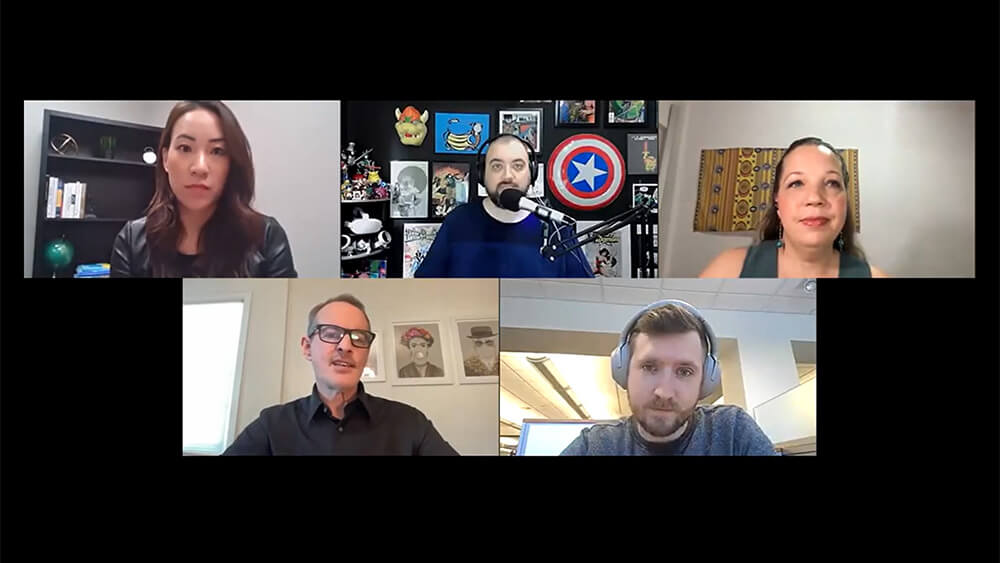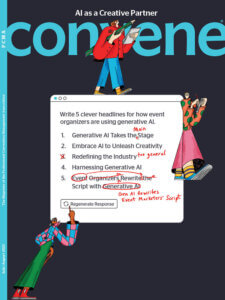
During a PCMA webinar in June, event professionals Anh Nguyen (clockwise from left), Nick Borelli, Jen Santos, and Matthias Clock shared how they are using AI. Howard Givner (bottom left) moderated the session.
At the beginning of a PCMA webinar in June, “Dissecting the ChatGPT/Generative AI Disruption: Use Cases, Concerns, Threats & Opportunities for Event Profs,” moderator Howard Givner, PCMA’s senior vice president of knowledge & innovation and founder of the Event Leadership Institute, asked the audience how often, if at all, they use AI for work. Half said never; two out of five said sometimes; and only 10 percent said they are using generative AI regularly.

Part of our July/August cover and CMP Series. (Sergio Membrillas illustration)
Audience members who are finding a use for AI tools, according to their comments in the chat, are experimenting with scriptwriting, research, marketing, copy, RFPs, and emails.
The webinar then moved on to the four event professional speakers — Jen Santos, event-tech expert; Nick Borelli, marketing director for facial analysis company Zenus; Anh Nguyen, founder of Spark Event Management; and Matthias Clock, marketing director at RX (Reed Exhibitions) — who each shared how they’ve been using generative AI in their day-to-day work.
‘I Treat It Almost Like It Is Another Person’
“I love it for brainstorming and ideation and coming up with things that I wouldn’t have thought about,” Santos said. She said that she uses AI tools to create names of expo spaces and for such everyday tasks as removing the background in a speaker photo. She uses cockatoo.com to generate transcripts from videos (such as webinars), and then asks ChatGPT to create a lesson outline or posts for social media from that transcript.
Santos said she is not a fan of using generative AI for research because of the need to fact-check what it spits out. The way Santos approaches an AI tool is to think of it less like a machine and “more like a type of contractor — a graphic designer or a creative consultant. You’re kind of talking to it like that. I enjoy working with ChatGPT because I do treat it almost like it is another person.” In fact, Santos shared that she makes it a point to be polite when using ChatGPT, regularly using “please,” “thank you,” and “great job” in her prompts.
Designing a More Human Experience
“One of the most interesting parts of generative AI is not necessarily just the answer, but how it got there,” Borelli said. “Not only does it explain to you what the thinking behind it is, it also gives you inspiration for more input to add to it because then you can start explaining to other people how you got there.”
Borelli works with AI tools like Bard to research and draft ideas to free up time. AI “gives you an opportunity to ask better questions,” he said. “And to design for more of a human experience” — although the irony of using AI for a better human experience, he said, was not lost on him. He prefers using Bard because it allows you to take advantage of Google’s more up-to-date information, “especially when you’re looking at site selection, another example of something where a lot of things can change and therefore Bard might end up being a better resource than ChatGPT.”
‘How You Save Time so You Can Do the Things You’re Good at’
As for Nguyen, she said she is saving time with Canva’s AI functionality or Firefly to create banners, a registration system, marketing materials, and fixing speaker photos — “my biggest pet peeve is getting backlogged or bottle- necked by a graphic designer.”
The time she saves is spent thinking more strategically about events “so that I can focus more of my time on that, being a service-based agency.” One thing she has learned about AI “is it never works the same way twice,” she added.
She has used Bing to create a chart, using the prompt: “Show me a table with the data that I can copy and paste and write the code for Google Sheets macro to automatically draw a bar chart for each year showing the breakdown between the genders.”
The most important thing event professionals should be thinking about in terms of AI, Nguyen said, “is how you save time so that you can do the things that you’re good at and that you’re paid for and that you’re experts in, which is the strategic, the creative, the thinking about the human design.”
Creating a Brand Voice
Clock said his goal in participating in the webinar was to “open your mind just a little bit more” about some of the opportunities for generative AI in events, like its ability to create a script for a video. “Something that might have taken me a week of procrastination and Google searching and trying to find a template and all that” was accomplished in a matter of minutes, he said. He said he asks in his prompts for responses to be delivered in his company’s “brand voice. I think this is actually going to be a standard type of prompt that marketing teams have going into the future. What I’m going to be doing is creating a brand voice prompt, that I can then use to create new language for new show features or new initiatives within the brand voice — so that instead of generic text or sloppily or hastily characterized text, the output will be within my brand voice at all times.”
Clock also didn’t want the audience to lose sight of the fact that working with ChatGPT is a process of continual improvement. “The important rule or idea here,” he said, is that “you can ask ChatGPT to help you use ChatGPT, right?”

Anh Nguyen
Keeping an Eye on AI
Webinar panelist Anh Nguyen said she had noticed that questions around ethics and legality had come up in the chat and said those shouldn’t be ignored.
We don’t know what the effects of AI will be on society, Clock said, and admitted he was a bit conflicted about “helping in the mass adoption of this technology,” he said. “We are undoubtedly in the honeymoon phase of AI. Just like we had a honeymoon phase with social media, a honeymoon phase with cryptocurrency, etc. And it isn’t to say that those tools don’t have value or social value, but as a society we kind of rush in with open arms and embrace these technologies, particularly social media — the promise of connecting everyone more deeply. I think the data has shown over the last 15 to 20 years that there have been some massive social costs.”
Magdalina Atanassova is digital media editor at Convene.
Watch the Webinar
If you are a PCMA member, you can view the “Dissecting the ChatGPT/Generative AI Disruption: Use Cases, Concerns, Threats & Opportunities for Event Profs” webinar here.
